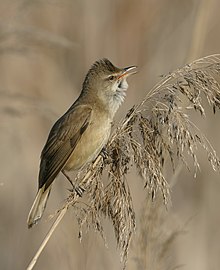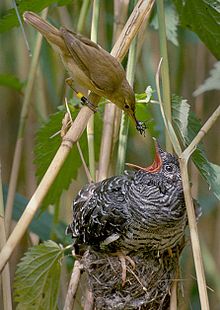A | B | C | D | E | F | G | H | CH | I | J | K | L | M | N | O | P | Q | R | S | T | U | V | W | X | Y | Z | 0 | 1 | 2 | 3 | 4 | 5 | 6 | 7 | 8 | 9
| Acrocephalus | |
|---|---|

| |
| Great reed warbler, Acrocephalus arundinaceus | |
| Scientific classification | |
| Domain: | Eukaryota |
| Kingdom: | Animalia |
| Phylum: | Chordata |
| Class: | Aves |
| Order: | Passeriformes |
| Family: | Acrocephalidae |
| Genus: | Acrocephalus J. A. Naumann and J. F. Naumann, 1811 |
| Type species | |
| Turdus arundinaceus[1] Linnaeus, 1758
| |
| Species | |
|
See text | |
The Acrocephalus warblers are small, insectivorous passerine birds belonging to the genus Acrocephalus. Formerly in the paraphyletic Old World warbler assemblage, they are now separated as the namesake of the marsh and tree warbler family Acrocephalidae. They are sometimes called marsh warblers or reed warblers, but this invites confusion with marsh warbler and reed warbler.
These are rather drab brownish warblers usually associated with marshes or other wetlands. Some are streaked, others plain. Many species breeding in temperate regions are migratory.
This genus has heavily diversified into many species throughout islands across the tropical Pacific. This in turn has led to many of the resulting insular endemic species to become endangered. Several of these species (including all but one of the species endemic to the Marianas and two endemic to French Polynesia) have already gone extinct.
The most enigmatic species of the genus, the large-billed reed warbler (A. orinus), was rediscovered in Thailand in March, 2006; it was found also in a remote corner of Afghanistan in the summer of 2009. Prior to these recent sightings, it had been found only once before, in 1867.
Taxonomy
The genus Acrocephalus was introduced in 1811 by the German naturalist Johann Andreas Naumann and his son Johann Friedrich Naumann.[2][3] The type species was designated as Turdus arundinaceus Linnaeus, 1758, by the English zoologist George Gray in 1840. This is the great reed warbler.[4][5] Many species have a flat head profile, which gives rise to the genus name, Acrocephalus from Ancient Greek akros, "highest", and kephale, "head". It is possible that the Naumanns thought akros meant "sharp-pointed".[6]
List of species in taxonomic order

The genus contains 42 species of which 6 insular forms are now extinct:[7]
- Basra reed warbler, Acrocephalus griseldis
- Cape Verde warbler, Acrocephalus brevipennis
- Greater swamp warbler, Acrocephalus rufescens
- Lesser swamp warbler, Acrocephalus gracilirostris
- Madagascar swamp warbler, Acrocephalus newtoni
- Seychelles warbler, Acrocephalus sechellensis
- Rodrigues warbler, Acrocephalus rodericanus
- Great reed warbler, Acrocephalus arundinaceus
- Oriental reed warbler, Acrocephalus orientalis
- Clamorous reed warbler, Acrocephalus stentoreus
- Australian reed warbler, Acrocephalus australis
- Millerbird, Acrocephalus familiaris
- † Nightingale reed warbler, Acrocephalus luscinius
- Saipan reed warbler, Acrocephalus hiwae
- † Aguiguan reed warbler, Acrocephalus nijoi
- † Pagan reed warbler, Acrocephalus yamashinae
- † Mangareva reed warbler, Acrocephalus astrolabii
- Nauru reed warbler, Acrocephalus rehsei
- Caroline reed warbler, Acrocephalus syrinx
- Bokikokiko, Acrocephalus aequinoctialis
- Northern Marquesan reed warbler, Acrocephalus percernis
- Tahiti reed warbler, Acrocephalus caffer
- † Moorea reed warbler, Acrocephalus longirostris
- † Garrett's reed warbler, Acrocephalus musae
- Southern Marquesan reed warbler, Acrocephalus mendanae
- Tuamotu reed warbler, Acrocephalus atyphus
- Cook reed warbler, Acrocephalus kerearako
- Rimatara reed warbler, Acrocephalus rimitarae
- Henderson reed warbler, Acrocephalus taiti
- Pitcairn reed warbler, Acrocephalus vaughani
- Black-browed reed warbler, Acrocephalus bistrigiceps
- Moustached warbler, Acrocephalus melanopogon
- Aquatic warbler, Acrocephalus paludicola
- Sedge warbler, Acrocephalus schoenobaenus
- Speckled reed warbler, Acrocephalus sorghophilus
- Blunt-winged warbler, Acrocephalus concinens
- Manchurian reed warbler, Acrocephalus tangorum (sometimes included in A. agricola)
- Large-billed reed warbler, Acrocephalus orinus
- Paddyfield warbler, Acrocephalus agricola
- Blyth's reed warbler, Acrocephalus dumetorum
- Common reed warbler, Acrocephalus scirpaceus
- Marsh warbler, Acrocephalus palustris
Fragmentary fossil remains from the Late Miocene (about 11 mya) of Rudabánya (NE Hungary) show some apomorphies typical of this genus.[8] Given its rather early age (most Passerida genera are not known until the Pliocene), it is not too certain that it is correctly placed here, but it is highly likely to belong to the Acrocephalidae at the least.
References
- ^ "Acrocephalidae". aviansystematics.org. The Trust for Avian Systematics. Retrieved 2023-07-15.
- ^ Naumann, Johann Andreas; Naumann, Johann Friedrich (1811). Naturgeschichte der Land- und Wasser-Vögel des nördlichen Deutschlands und angränzender Länder, nach eigenen Erfahrungen entworfen, und nach dem Leben gezeichnet. Nachtrag (in German). Köthen: Self-published. p. 199.
- ^ Mayr, Ernst; Cottrell, G. William, eds. (1986). Check-list of Birds of the World. Vol. 11. Cambridge, Massachusetts: Museum of Comparative Zoology. p. 56.
- ^ Gray, George Robert (1840). A List of the Genera of Birds : with an Indication of the Typical Species of Each Genus. London: R. and J.E. Taylor. p. 21.
- ^ Dickinson, E.C.; Christidis, L., eds. (2014). The Howard & Moore Complete Checklist of the Birds of the World. Vol. 2: Passerines (4th ed.). Eastbourne, UK: Aves Press. p. 472. ISBN 978-0-9568611-2-2.
- ^ Jobling, James A (2010). The Helm Dictionary of Scientific Bird Names. London: Christopher Helm. p. 30. ISBN 978-1-4081-2501-4.
- ^ Gill, Frank; Donsker, David; Rasmussen, Pamela, eds. (January 2020). "Bushtits, leaf warblers, reed warblers". IOC World Bird List Version 11.1. International Ornithologists' Union. Retrieved 1 July 2021.
- ^ Bernor R.L.; Kordos L.; Rook L. (2002). "Recent Advances on Multidisciplinary Research at Rudabánya, Late Miocene (MN9), Hungary: a compendium" (PDF). Palaeontographia Italica (89): 3–36.
Further reading
- Olsson, U.; Rguibi-Idrissi, H.; Copete, J.L.; Arroyo Matos, J.L.; Provost, P.; Amezian, M.; Alström, P.; Jiguet, F. (2016). "Mitochondrial phylogeny of the Eurasian/African reed warbler complex (Acrocephalus, Aves). Disagreement between morphological and molecular evidence and cryptic divergence: A case for resurrecting Calamoherpe ambigua Brehm 1857". Molecular Phylogenetics and Evolution. 102: 30–44. Bibcode:2016MolPE.102...30O. doi:10.1016/j.ympev.2016.05.026. PMID 27233439.
External links
- Acrocephalus videos Archived 2016-03-14 at the Wayback Machine on the Internet Bird Collection
Great reed warbler
Taxonomy (biology)
Template:Taxonomy/Acrocephalus (bird)
Eukaryote
Animal
Chordate
Bird
Passerine
Acrocephalidae
Johann Andreas Naumann
Johann Friedrich Naumann
Type species
Great reed warbler
Species
Passerine
Bird
Paraphyletic
Old World warbler
Acrocephalidae
Marsh warbler
Eurasian reed warbler
Marsh
Bird migration
Pacific Ocean
Endemism
Endangered species
Mariana Islands
French Polynesia
Extinction
Large-billed reed warbler
Thailand
Afghanistan
Johann Andreas Naumann
Johann Friedrich Naumann
Type species
Carl Linnaeus
George Robert Gray
Great reed warbler
Ancient Greek
File:Reed warbler cuckoo.jpg
Eurasian reed warbler
Common cuckoo
Basra reed warbler
Cape Verde warbler
Greater swamp warbler
Lesser swamp warbler
Madagascar swamp warbler
Seychelles warbler
Rodrigues warbler
Great reed warbler
Oriental reed warbler
Clamorous reed warbler
Australian reed warbler
Millerbird
Nightingale reed warbler
Saipan reed warbler
Aguiguan reed warbler
Pagan reed warbler
Mangareva reed warbler
Nauru reed warbler
Caroline reed warbler
Bokikokiko
Northern Marquesan reed warbler
Tahiti reed warbler
Moorea reed warbler
Garrett's reed warbler
Southern Marquesan reed warbler
Tuamotu reed warbler
Cook reed warbler
Rimatara reed warbler
Henderson reed warbler
Pitcairn reed warbler
Black-browed reed warbler
Moustached warbler
Aquatic warbler
Sedge warbler
Speckled reed warbler
Blunt-winged warbler
Manchurian reed warbler
Large-billed reed warbler
Paddyfield warbler
Blyth's reed warbler
Common reed warbler
Marsh warbler
Fossil
Late Miocene
Rudabánya
Hungary
Apomorph
Passerida
Pliocene
Johann Andreas Naumann
Johann Friedrich Naumann
Ernst Mayr
George Robert Gray
Edward C. Dickinson
Leslie Christidis
ISBN (identifier)
Special:BookSources/978-0-9568611-2-2
ISBN (identifier)
Special:BookSources/978-1-4081-2501-4
Frank Gill (ornithologist)
Pamela Rasmussen
Bibcode (identifier)
Doi (identifier)
PMID (identifier)
Category:Acrocephalus
Wayback Machine
Template:Passerida
Template talk:Passerida
Special:EditPage/Template:Passerida
Passerida
Animal
Chordate
Birds
Passeri
Passerida
Passerida
Chaetopidae
Chaetops
Chloropseidae
Chloropsis
Hyliotidae
Hyliota
Irenidae
Irena (bird)
Paridae
Baeolophus
Cyanistes
Cephalopyrus
Lophophanes
Machlolophus
Melaniparus
Melanochlora
Pardaliparus
Parus
Periparus
Poecile
Pseudopodoces
Sittiparus
Sylviparus
Picathartidae
Picathartes
Promeropidae
Promerops
Remizidae
Anthoscopus
Auriparus
Remiz
Stenostiridae
Chelidorhynx
Culicicapa
Elminia
Stenostira
Muscicapida
Sylvioidea
Passeroidea
Template:Passeroidea
Muscicapida
Regulidae
Corthylio
Regulus (bird)
Bombycilloidea
Bombycillidae
Bombycilla
Dulidae
Dulus
Hylocitreidae
Hylocitrea
Hypocoliidae
Hypocolius
Mohoidae
Chaetoptila
Moho (genus)
Ptiliogonatidae
Phainopepla
Phainoptila
Ptiliogonys
Certhioidea
Kischinskinia
Certhiidae
Certhia
Salpornis
Polioptilidae
Microbates
Polioptila
Ramphocaenus
Sittidae
Sitta
Tichodromidae
Tichodroma
Troglodytidae
Campylorhynchus
Cantorchilus
Catherpes
Cinnycerthia
Cistothorus
Cyphorhinus
Ferminia
Henicorhina
Hylorchilus
Microcerculus
Odontorchilus
Pheugopedius
Salpinctes
Thryomanes
Thryophilus
Thryorchilus
Thryothorus
Troglodytes (bird)
Uropsila
Muscicapoidea
Buphagidae
Buphagus
Cinclidae
Cinclus
Elachuridae
Elachura
Mimidae
Allenia
Cinclocerthia
Dumetella
Margarops
Melanotis
Mimus
Oreoscoptes
Ramphocinclus
Toxostoma
Muscicapidae
Chamaetylas
Cichladusa
Cossypha
Cossyphicula
Dessonornis
Erithacus
Pogonocichla
Sheppardia
Stiphrornis
Swynnertonia
Xenocopsychus
Muscicapinae
Alethe (genus)
Cercotrichas
Copsychus
Agricola (bird)
Bradornis
Empidornis
Fraseria
Humblot's flycatcher
Melaenornis
Muscicapa
Namibornis
Sigelus
Anthipes
Cyanoptila
Cyornis
Eumyias
Leucoptilon
Niltava
Sholicola
Saxicolinae
Brachypteryx
Calliope (genus)
Campicoloides
Cinclidium (bird)
Emarginata
Enicurus
Ficedula
Heinrichia
Heteroxenicus
White-throated robin
Larvivora
Leonardina
Luscinia
Monticola
Myiomela
Myophonus
Myrmecocichla
Oenanthe (bird)
Phoenicurus
Pinarochroa
Saxicola
Tarsiger
Thamnolaea
Vauriella
Sturnidae
Acridotheres
Agropsar
Ampeliceps
Aplonis
Arizelopsar
Basilornis
Cinnyricinclus
Creatophora
Cryptopsar
Enodes
Fregilupus
Goodfellowia
Gracula
Gracupica
Grafisia
Hartlaubius
Hylopsar
Lamprotornis
Leucopsar
Mino (bird)
Necropsar
Neocichla
Notopholia
Onychognathus
Pastor (bird)
Pholia
Poeoptera
Rhabdornis
Sarcops
Saroglossa
Scissirostrum
Speculipastor
Updating...x
Text je dostupný za podmienok Creative
Commons Attribution/Share-Alike License 3.0 Unported; prípadne za ďalších
podmienok.
Podrobnejšie informácie nájdete na stránke Podmienky
použitia.

